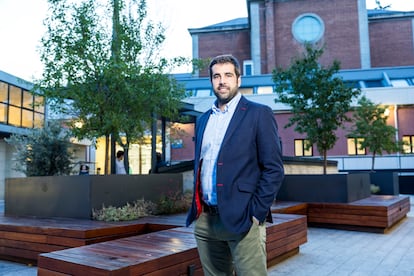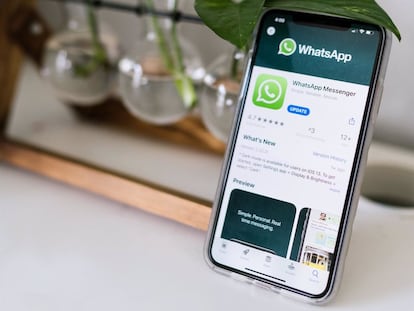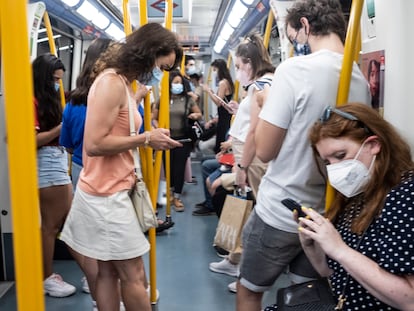Marc Masip, cellphone addiction specialist: ‘The most severe symptoms we see in teens take place in their bedrooms’
The psychologist and founder of Desconecta, a therapeutic and educational support project for minors with tech addiction, says that the earlier kids receive a cellphone, the more problems they experience in face-to-face relationships


In 2016, at age 36, Barcelona-born Marc Masip anticipated cartoonist Chris Ware’s work in the November 27 issue of The New Yorker. The U.S. illustrator drew a Thanksgiving dinner in which everyone sitting around the table is on their cellphone reviewing, editing and sharing the photos taken that very night, in an attempt to “edit life into something that looks like the perfect representation of happiness,” in the words of Ware. In the summer of 2016, there was hardly any talk yet of the tremendous impact of smartphones on social relationships. Masip posted a photo to Twitter (now X) of an entire family eating at a restaurant on the Costa Brava in which the only one not looking at their mobile screen was a child, who contemplated the moment. “It was a very shocking image and I even got calls from TV stations to comment on it,” says the psychologist and founder of the Desconecta [Disconnect] project, which was launched in 2012 to provide therapeutic and educational support to kids between the ages of 11 and 17 with problems of addiction to technology or mental health disorders.
Nowadays, Masip is responsible for three facilities in Barcelona, Madrid and Málaga in which 420 youngsters receive treatment in out-patient hospitals and something called therapeutic classrooms, which stand in for conventional educational facilities and offer an academic program adapted to the needs of the patient. Some feature resources such as teachers who personalize study techniques in six-person classrooms. All this is funded by the National Institute of Social Security via school insurance, and families are only required to pay a “residual” part of monthly fees.
Question. What made you think about the danger of technology back in 2012?
Answer. Desconecta was born in an era in which society was still not aware of the risks of being hooked on cellphones. The dependence created by technology has surpassed all educational and health predictions. At that time, I was called crazy. Now, it’s clear I was a visionary. What we launched back then was the first psycho-educational program for addiction to technology, social media and video games. We started to see a lot of teenagers who were hooked, but we didn’t understand the origin of their pathologies. Now, we know that the pathology itself is usually there before they use their device, which becomes a loudspeaker of the problem. For example, the girls who suffer from anorexia and turn to social media to compare their bodies, or the cases that begin as school absenteeism and end up as social phobia due to lockdown, and all the time that kids spent in their rooms with their devices. It is important to remember that the World Health Organization (WHO) still does not recognize addiction to cellphones and technology as a disease, as it has with video games since 2022. I think it is a matter of time.
Q. We’re starting to see the consequences. Have you seen demand increase at your centers?
A. In 2021 we began with individual sessions, but soon we saw that one hour per week was not enough, that there was no consistency or therapeutic connection. And so we began the next phase: out-patient hospitalization and therapeutic classrooms. Kids come every day to our facilities for more than six hours and do individual, group and family therapy, plus workshops. This part is mandatory, we need families to be involved, otherwise it is impossible to move forward with their children. In the therapeutic classrooms, we build up the academic component. We have six-student classrooms, at middle school and high school levels, and they get a personalized study plan once a week, no homework. They have a psychologist, psychiatrist and at the same time, math, language and English classes. Last year we had a 97 percent passing rate. The majority of our students come to us with a mental health disorder, and we’ve seen that technology plays an important role in all their conditions.
Q. So adolescents turn to your facilities after they’ve left school?
A. No, they’re kids who want to study, but they can’t go to a conventional school. A young person who has a phobia or is doing poorly isn’t going to be able to deal with a classroom with 30 other kids. Attention deficit hyperactivity disorder (ADHD) doesn’t operate the same way in large groups as it does in smaller ones. For the academic component, we have agreements with schools like the Agora International School — a private school for kids from four months to 18 years of age — and the Zurich Schüle in Barcelona, Madrid and Málaga, where we opened a month ago. The kids study at our educational facilities, but it’s the schools that grade them and issue their diplomas. There are 100 students per center and we cannot and don’t want to take on any more. Speaking in terms of the out-patient hospitals, the average length of recovery is a year and a half.
Q. What advantages are there to putting only kids with mental health disorders in a classroom? Isn’t that akin to taking them out of society and putting them into an unrealistic setting?
A. The most important thing is that they are in a safe environment. It’s the other kind of environment where they aren’t doing well. Sometimes parents ask you, “Hey, who is my kid going to be around? Their kid ends up being the one with the most complex or conflict-prone situation. Children come to us when they are ill or have a special educational need, they are minors who suffer every day that they go to school. There are many kids who go to high school every day thinking about how they want to kill themselves and they don’t tell a soul, not even their parents. This, on the other hand, is an environment in which they are taken care of.
Q. When they go to college, will they continue to have support?
A. They’ll already be adults at that point, and you have to have prepared them to leave the program. At any educational program, graduating from high school to college is a big leap. The same goes for these kids. When they leave here, they’ll have acquired study techniques and autonomy. In the case of a relapse, there’s always therapeutic accompaniment.
Q. When teens come to you with serious cellphone addiction problems, how do you address the issue?
A. Treatments for cellphone addiction are complex because, as you know, this is an element with which we have to learn to coexist, which makes it unlike an addiction to a substance, which you can quit once and for all. You can use your cellphone responsibly, although we are still in the process of trial and error when it comes to how. Withdrawal in these cases has a very high, potent spike, but it comes down quickly, in contrast to drugs, with which the urge to consume stays high. What a human being most desires is to be free, and they find a lot of freedom in their cellphone. They use them the most in bed and in the bathroom, and more at night than in the daytime, because they’re under less supervision. There are kids who, if they hadn’t received their cellphone so early on, wouldn’t be so sick now. For example, if you give a 12-year-old kid the freedom to lock themselves in their room with their cellphone, you can’t expect them to know how to use it responsibly. Many of the kids who come to us with a pornography addiction started like that. Their brain wasn’t mature enough to deal with all the possibilities. The most severe symptoms we see in teens take place in their bedrooms.
Q. When you suggest to families that they shouldn’t give their kids cellphones so early on, I imagine their reaction has to do with not wanting to exclude them from their friend group, since the primary method of communication these days is Whatsapp and Instagram.
A. We explain to them that this is not going to cause any trauma, that it’s not true that you won’t have friends if you don’t have a smartphone. If they don’t find out about birthday parties from not being in a Whatsapp group, the real problem is not the chat, it’s the kid. The most important thing is for them to understand that you won’t be more socially integrated with a smartphone, in fact it leads to more social isolation. We have to insist that parents educate themselves and take action. In part, it’s true that they haven’t been informed of the dangers, and that tech companies aren’t going to take on that job because these children are the product. It’s an issue that has overwhelmed us, that we didn’t see coming. Now, parents are starting to take their heads out of the sand. I would also say that there are children with diagnosed pathologies who do not follow treatment because of their parents’ denial, which comes from fear.
Q. Are you seeing that face-to-face relationships are hard for young people?
A. Adolescents are cowardly in their relationships. They have a lot of ability for relating through screens and saying anything: I love you, you’re my friend. But then face to face, they’ve lost the ability for real interrelation. We’ve got to take two steps back with technology and recover human relationships. It’s true that not all the responsibility lies with families. We’ve got to control technology, put limits on it, for example, by banning the infinite scroll option, which is an addictive element. The person who created the infinite scroll has acknowledged in various interviews that they are sorry that they made it. The blue double check is another element of control. What is going to hold these technologies in check — the self-control of a 12-year-old? We urgently need government regulation.
Q. Would you tell families that they should say no to cellphones until their kids are 16 years old?
A. Let’s say 16 so as not to say something truly wild [meaning 18]. I would say to families that, if you have children, you have to be ready to spend time with them. Screens can be a very comfortable substitute [for a parent’s presence] when they’re little, but when these pathologies arise, they can turn into something that is very uncomfortable. How many of these cases could have been averted if the family had been more aware? It’s necessary to study, to read, and to know when to say no.
Sign up for our weekly newsletter to get more English-language news coverage from EL PAÍS USA Edition
Tu suscripción se está usando en otro dispositivo
¿Quieres añadir otro usuario a tu suscripción?
Si continúas leyendo en este dispositivo, no se podrá leer en el otro.
FlechaTu suscripción se está usando en otro dispositivo y solo puedes acceder a EL PAÍS desde un dispositivo a la vez.
Si quieres compartir tu cuenta, cambia tu suscripción a la modalidad Premium, así podrás añadir otro usuario. Cada uno accederá con su propia cuenta de email, lo que os permitirá personalizar vuestra experiencia en EL PAÍS.
¿Tienes una suscripción de empresa? Accede aquí para contratar más cuentas.
En el caso de no saber quién está usando tu cuenta, te recomendamos cambiar tu contraseña aquí.
Si decides continuar compartiendo tu cuenta, este mensaje se mostrará en tu dispositivo y en el de la otra persona que está usando tu cuenta de forma indefinida, afectando a tu experiencia de lectura. Puedes consultar aquí los términos y condiciones de la suscripción digital.
More information
Archived In
Últimas noticias
Most viewed
- Sinaloa Cartel war is taking its toll on Los Chapitos
- Oona Chaplin: ‘I told James Cameron that I was living in a treehouse and starting a permaculture project with a friend’
- Reinhard Genzel, Nobel laureate in physics: ‘One-minute videos will never give you the truth’
- Why the price of coffee has skyrocketed: from Brazilian plantations to specialty coffee houses
- Silver prices are going crazy: This is what’s fueling the rally










































